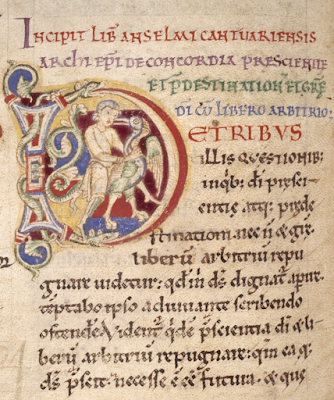Weekly update 2
 |
| From an early MS of Anselm's last work, De concordia |
I'm about a thousand words ahead of my goal, which is fantastic, because next week I'm attending a virtual conference and will be pressed for time to get writing done. In addition to having over two-thirds of Chapter 3 written, I have some of the Further Reading section drafted. I'm also making the list of illustrations. The book doesn't really need much in the way of illustrations, and the press has told me not to add illustrations just for the sake of having them, but a few of them might add some interest. Certainly there should be an illustration from a manuscript, like the one above. (Too bad they'll all be in black and white.) A map of the key places would be helpful. Right now I just have an instruction for them to find or produce a map that includes all the places mentioned in Chapter 1. Since I have yet to write Chapter 1, this directive will need a bit of tweaking before I submit the list on July 15. I also want something that shows Anselm's reluctance to accept the archbishopric. This might do:
I've finished up the week writing about Anselm's response to the first (and most celebrated) critic of his ontological argument, an otherwise unknown monk named Gaunilo. This excerpt begins with Anselm's summary of Gaunilo's main criticisms as he understands them and then explicates two arguments (or really two variations of one form of argument) that Anselm offers in his reply. My possible-but-non-existent brother Jason, who is familiar to my students, puts in an important appearance.
At the
beginning of his reply to Gaunilo, Anselm summarizes what he takes to be
Gaunilo’s two main criticisms. First, it is not actually possible to think that
than which a greater cannot be thought: we can say the words, but the being
itself eludes our capacity to paint the mental portrait of God that Anselm
claims we have. We’ll call this the unthinkability objection. Second,
even if we could think that being, we would not be entitled to conclude
that the being exists in reality, outside the mind; we can think any number of
beings that don’t exist, so what’s so special about this one? Because Gaunilo
describes thoughts of non-existing things as “false,” we’ll call this the false-thoughts
objection.
We needn’t spend much time on
Anselm’s answer to the unthinkability objection, because by now it’s very
familiar: we go about forming a thought of God, painting a mental portrait of
God, in the ways we saw in Chapter 2. Though the being we come to think in this
way is certainly far removed from the objects of our everyday experience, there
is a clear path from those objects to the being than which a greater cannot be
thought. We experience good things, and better things, and on that basis we can
conceive a being of unsurpassable goodness, one that does not derive its
goodness from anything else but is the source of its own goodness and of the
goodness of all other good things—and so on for all the other characterizations
of the perfect, unlimited, simple God that we derive ultimately from our
experience of imperfect, limited, and fragmented creatures.
The false-thoughts objection
receives much more of Anselm’s attention. He sees that he must show Gaunilo
that there are features of our thought of God that guarantee God’s existence:
as he puts it, “I say with certainty that if it can be so much as thought to
exist, it must necessarily exist.” Anselm offers nine different arguments for
the claim that if God can be thought, he must exist in reality, each following
the same basic pattern. It is easiest to explain the form of the arguments if
we introduce a technical term from contemporary philosophy: merely possible.
Something is merely possible if it is (a) possible but (b) non-existent. My
older brother Jason is merely possible: (a) my parents could have started their
family earlier, and they could have had a boy and named him Jason; but (b) they
did not, and in fact I am their firstborn. Anselm’s technique is to argue that
there are features of our portrait of God that cannot belong to a merely
possible being. So, since God is possible—remember, we can’t think
impossibilities, and we can think God—it follows that God actually exists.
To see how this pattern of argument
is supposed to work, let’s look at two of the nine versions Anselm offers. In
the first version, the feature that cannot belong to a merely possible being is
beginningless:
That than which a greater cannot be thought cannot be thought of as
beginning to exist. By contrast, whatever can be thought to exist, but does not
in fact exist, can be thought of as beginning to exist. Therefore, it is not
the case that that than which a greater cannot be thought can be thought to
exist, but does not in fact exist. If, therefore, it can be thought to exist,
it does necessarily exist.
This is a hard
argument to evaluate. Does Anselm mean that any merely possible being can be
thought to have a beginning at some point, or that any merely possible
being can be thought to have a beginning now? Consider my merely
possible older brother Jason. If he had come to exist, he would have had a
beginning in the ordinary way; but it’s too late now. If Anselm is arguing that
it’s too late now for a merely possible beginningless being to exist (because
obviously it would have to begin to exist, since it doesn’t exist already),
that’s correct, but hardly relevant. Jason is still possible even though it’s
too late for him to (begin to) exist. So for Anselm’s argument to work, he has
to mean that any merely possible being can be thought to have a beginning at
some point. But is that really the case? It seems to me that I can imagine a
merely possible beginningless being: a being that, if it had existed, would
never have begun to exist but would have just always been there. Perhaps I am
wrong in so thinking, but I can at least see why Gaunilo need not concede yet.
Far more convincing is another
feature of that than which a greater cannot be thought that Anselm says cannot
belong to a merely possible being: necessary existence. It is obvious that a
being that can fail to exist is less great than a being that cannot fail to
exist: it has a more tenuous hold on being, it does not have the source of its
own being in itself, it must depend on something else to bring it into
existence, and so forth. So that than which a greater cannot be thought is a
necessary being; it cannot fail to exist. Anselm invites us to get that being
before our minds. Does such a being exist in reality? It must. We cannot
coherently say “A being than which a greater cannot be thought is possible but
does not exist,” because one thing we know about a being than which a greater
cannot be thought is that, if it exists, it cannot fail to exist. That is,
whatever being we’re thinking when we say “A being than which a greater cannot
be thought is possible but does not exist” is not in fact a being than which a
greater cannot be thought.
Anselm puts the argument like this:
Let us assume that [that than which a greater cannot be thought] does not
exist, although it can be thought. Now something that can be thought but does
not exist would not, if it existed, be that than which a greater cannot be
thought. And so, if it existed, that than which a greater cannot be thought
would not be that than which a greater cannot be thought, which is utterly
absurd. Therefore, if that than which a greater cannot be thought can be
thought at all, it is false that it does not exist.
This last claim—if
it can be thought, it exists—is the claim that Anselm defends in nine different
ways in his reply to Gaunilo. Combined with his argument that it can be
thought, this claim gives Anselm a simple, straightforward argument: two
premises, both of which he defends, and a conclusion that clearly follows from
them. The argument is this:
(1) If that than which a greater
cannot be thought can be thought, it exists.
(2) That than which a greater cannot
be thought can be thought.
Therefore, (3) that than which a
greater cannot be thought exists.
Reformulated in
more contemporary language, we have this:
(1) If a perfect being is possible,
it exists.
(2) A perfect being is possible.
Therefore, (3) a perfect being exists.
This argument
is known as the modal ontological argument (“modal” meaning that it has
to do with possibility and necessity).




Comments
Post a Comment